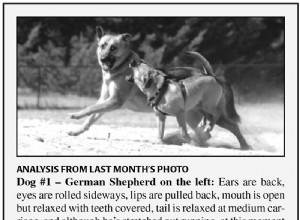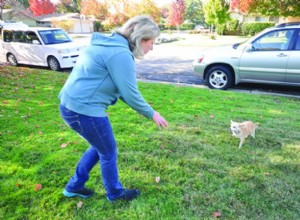犬がテーブルの隣に憧れて座っているとき、唾液のロープが床をたどり、あなたが唇に持ってきたジューシーなハンバーガーを見つめているとき、あなたの犬があなたに何を言おうとしているのかを判断するのはそれほど難しいことではありません.しかし、あなたが掃除機をかけているときに彼があくびをしたときはどうですか?家事は彼を退屈させますか?あなたがヨガのクラスから家に帰ったとき、彼が前足でお辞儀をし、後端を宙に浮かせたときはどうですか?彼は下向きの犬のポーズを披露していますか?
獣医師として、犬 (特に猫) が話せたらどれほど助かるかはわかりません。私の小児科医が彼の最年少の容疑について同じことを感じていることを私は知っています.獣医、ペット、およびその所有者にとっての朗報は、犬の行動とボディーランゲージに関する長年の研究により、眉毛の上げ方、尻尾のフリック、カールした唇が何を意味するのかについて多くの洞察が得られたことです.ボディーランゲージの手がかりを使用して行動を解読することで、ペットが苦しんでいるか、不安を感じているか、私に会えてうれしいか、ストレスを感じているかを判断するのに役立ちます.新しい親友。
犬が吠えたり、遠吠えしたり、泣き言を言ったりするのはどういう意味ですか?
まず、犬の DNA はその祖先である野生の犬やオオカミの DNA と密接に関連していることを覚えておくと役に立ちます。 As pack animals, there is a hierarchy in the group that is determined by social cues such as verbal sounds, body stance, tail position and facial expression.
Canine vocal sounds are usually the simplest of the clues humans can utilize to decide what a dog is trying to tell you. Whining:a high pitched soft sound can be heard from a dog that is in pain, anxious, frustrated or seeking attention when a bark has been discouraged. A whine and a whimper can sound similar. A bark, depending on the frequency, volume, and duration, can be used as an alert (read:the evil UPS man is coming to the door), to express excitement (accompanied by a tail wag and a grin), and as a sign of aggression when it is low pitched. Howling dogs may be anxious (think separation anxiety), attention-seeking, or trying to locate their “pack”. How about the dog that howls at the tv or a police siren? Those dogs may be telling the tv canine “hey, I’m here!” and possibly to back off their territory.
We can use body language along with vocalizations to best determine a dog’s emotional state. When in doubt, approach an unfamiliar dog slowly and from the side, avoiding eye contact which is threatening. Likewise, don’t reach over a dog’s head when first physically interacting. Some fearful or reactive dogs may see this as a scary gesture and reactive aggressively or back away, even if your pat was well intentioned.
Dog Body Language Is Relaxed and Approachable
So, what does a relaxed, happy, and approachable dog look like? In its most comfortable, unthreatened state, a dog may be lying on its belly, back legs splayed like a frog, on its back with the belly exposed and tail loose, or on the side with the eyes closed and legs extended. The dog’s ears are also relaxed and limp. In this position, the dog would be vulnerable to another animal or human and its reaction time would be delayed if attacked. Clearly, this is a dog that has no fear of an enemy! When standing, a content dog has its ears up but not forward, may have its tongue hanging out of a partially open mouth, a loose body with weight placed evenly on all four feet, head held high, and the tail down and relaxed. If approached, this dog may give a wag and a wiggle and come closer to be stroked.
Now picture this same dog who has detected the movement of a chipmunk. Alert and interested, the dog may close his mouth and tip his ears forward. His body weight may also shift to the front feet, ready to move if necessary. The tail will be held horizontally to the ground, possibly with a slight twitch, and the eyes will be wide open.
Understanding Dog Behavior With Other Canines
Let’s bring our pet to the dog park, where a particularly dominant dog is chasing our pup relentlessly and aggressively, possibly biting at his ears, and rolling him to the ground. Afraid? You bet! The fearful, submissive dog may roll on his back, tail pulled between his legs and may urinate. He will roll his head to the side but keep his eyelids open to watch for trouble, though any eye contact will be brief and indirect. His lips will be back, and mouth closed, or he may lick at the air or the dominant dog. The ears are generally flat and pulled back as well. Fido is scared and wants to head off further confrontation and attention! Yawning is also a sign of stress and anxiety in dogs. If we had been observant, we may have noticed this cue as well as a tucked tail as soon as Bruiser showed up.
And what about Bruiser? How can you tell a dog who is playing from a dog who is an aggressive bully? A dog bowing forward on its front legs, wagging its tail like a flag, with the ears erect and lips curved into a grin with the tongue out is giving the signal, “game on!” Usually, the dog remains in this position for just a few seconds before breaking into a “catch me if you can” type run. A play bow is distinctly different from the dog that approaches another dog with his hackles raised, a penetrating, unbreaking stare, body position forward, nose wrinkled, a stiff tail, and teeth partially visible. Back off without making eye contact and alert Bruiser’s owner that things are about to get ugly.
I hope these tips give you a little better idea what your dog may be trying to say. Be watchful of your body language as well as to those canines around you. Maybe even try a play bow next time you are home and watch your dog bounce with joy!

ただし、いずれの場合も、時間的に凍結された瞬間は、敵対的な(攻撃的な)表現ではなく、明確で適切な社会的行動の開始または継続に先行します。 人間が完全に通常の遊び行動を読み間違え、一緒に楽しい時間を過ごしている犬を中断/分離することは珍しいことではありません。私のグループのマナークラスの第2週の終わりに、そしてその後毎週、犬が犬のクラスメートと遊ぶためのプレイセッションがあります。新しいクラスにはそれぞれ、犬の遊び行動に非常に緊張している飼い主が少なくとも1人、多くの場合はそれ以上います。犬が遊んでいる間、ボディーランゲージの説明と説明をナレーションし、犬がお互いに実際に何を言っているのかを理

[2018年1月16日更新] おそらく、知らない犬と友達になりたいときに人間が犯す最も一般的な間違いは、彼をかがめて、彼の目を見て、頭を撫でることです。彼らが気付いていないのは、その相互作用に関するすべてが、平均的な犬の観点からは、失礼、失礼、失礼であるということです。おそらく知的な種の場合、私たち人間は犬の仲間とのコミュニケーションについて非常に密集している傾向があります。 犬とうまく仕事をする人は、犬とのやりとりの仕方について本能を持っているか、すぐに学びます。ボディーランゲージを使用して犬があなたの存在を安心させるのを助けるための本当の芸術があります。最も有能な専門家は、犬の